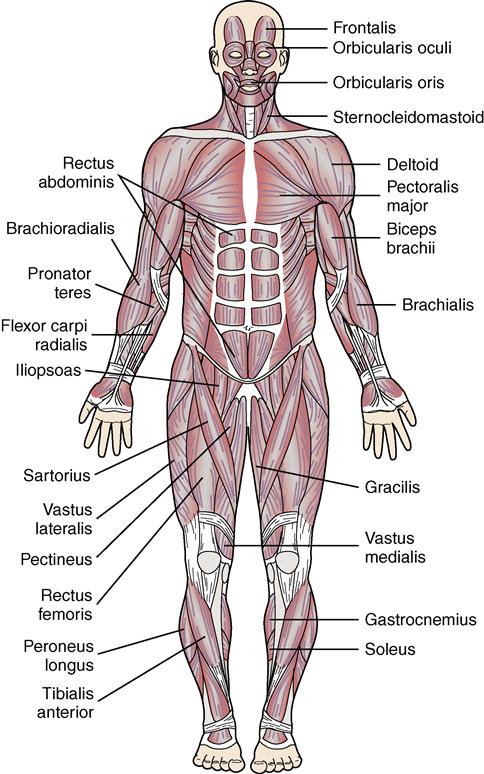Body structure and function
Objectives
• Define the key terms and key abbreviations listed in this chapter.
• Identify the basic structures of the cell.
• Describe four types of tissue.
• Identify the structures of each body system.
• Identify the functions of each body system.
Key terms
artery A blood vessel that carries blood away from the heart
capillary A tiny blood vessel; food, oxygen, and other substances pass from the capillaries into the cells
cell The basic unit of body structure
hemoglobin The substance in red blood cells that carries oxygen and gives blood its color
hormone A chemical substance secreted by the endocrine glands into the bloodstream
immunity Protection against a disease or condition; the person will not get or be affected by the disease
menstruation The process in which the lining of the uterus breaks up and is discharged from the body through the vagina
metabolism The burning of food for heat and energy by the cells
organ Groups of tissues with the same function
respiration The process of supplying the cells with oxygen and removing carbon dioxide from them
system Organs that work together to perform special functions
tissue A group of cells with similar functions
vein A blood vessel that returns blood to the heart
KEY ABBREVIATIONS
| GI | Gastro-intestinal |
| RBC | Red blood cell |
| WBC | White blood cell |
You help residents meet basic needs. Their bodies do not work at peak levels because of illness, disease, or injury. Your care promotes comfort, healing, and recovery. You need to know the body’s normal structure and function. It will help you understand signs, symptoms, and the reasons for care and procedures. You will give safe and more efficient care.
See Chapter 10 for changes in body structure and function that occur with aging.
Cells, tissues, and organs
The basic unit of body structure is the cell. Cells have the same basic structure. Function, size, and shape may differ. Cells are very small. You need a microscope to see them. Cells need food, water, and oxygen to live and function.
Figure 9-1 shows the cell and its structures. The cell membrane is the outer covering. It encloses the cell and helps it hold its shape. The nucleus is the control center of the cell. It directs the cell’s activities. The nucleus is in the center of the cell. The cytoplasm surrounds the nucleus. Cytoplasm contains smaller structures that perform cell functions. Protoplasm means “living substance.” It refers to all structures, substances, and water within the cell. Protoplasm is a semi-liquid substance much like an egg white.
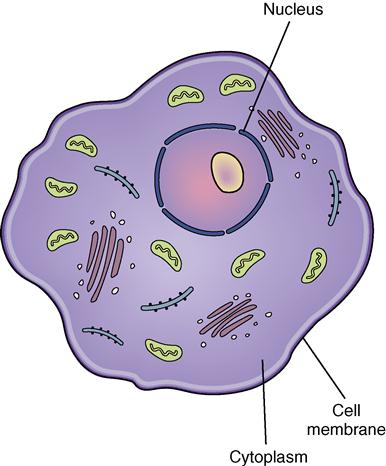
Chromosomes are thread-like structures in the nucleus. Each cell has 46 chromosomes. Chromosomes contain genes. Genes control the traits children inherit from their parents. Height, eye color, and skin color are examples.
The nucleus controls cell reproduction. Cells reproduce by dividing in half. The process of cell division is called mitosis. It is needed for tissue growth and repair. During mitosis, the 46 chromosomes arrange themselves in 23 pairs. As the cell divides, the 23 pairs are pulled in half. The two new cells are identical. Each has 46 chromosomes (Fig. 9-2).

Cells are the body’s building blocks. Groups of cells with similar functions combine to form tissues:
• Muscle tissue stretches and contracts to let the body move.
• Nerve tissue receives and carries impulses to the brain and back to body parts.
Groups of tissue with the same function form organs. An organ has one or more functions. Examples of organs are the heart, brain, liver, lungs, and kidneys. Systems are formed by organs that work together to perform special functions (Fig. 9-3).
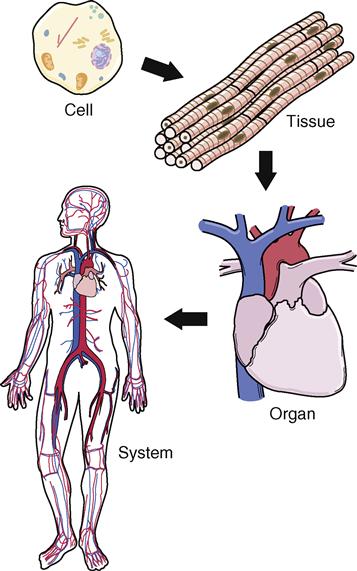
The integumentary system
The integumentary system, or skin, is the largest system. Integument means covering. The skin covers the body. It has epithelial, connective, and nerve tissue. It also has oil glands and sweat glands. There are two skin layers (Fig. 9-4):
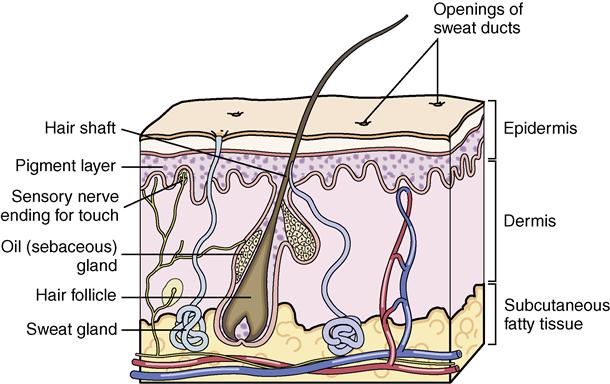
The epidermis and dermis are supported by subcutaneous tissue. The subcutaneous tissue is a thick layer of fat and connective tissue.
Oil glands and sweat glands, hair, and nails are skin appendages:
• Nails—protect the tips of the fingers and toes. Nails help fingers pick up and handle small objects.
• It is the body’s protective covering.
• It prevents microorganisms and other substances from entering the body.
• It prevents excess amounts of water from leaving the body.
• It protects organs from injury.
The musculo-skeletal system
The musculo-skeletal system provides the framework for the body. It lets the body move. This system also protects and gives the body shape.
Bones
The human body has 206 bones (Fig. 9-5). There are four types of bones:
• Long bones bear the body’s weight. Leg bones are long bones.
• Flat bones protect the organs. They include the ribs, skull, pelvic bones, and shoulder blades.
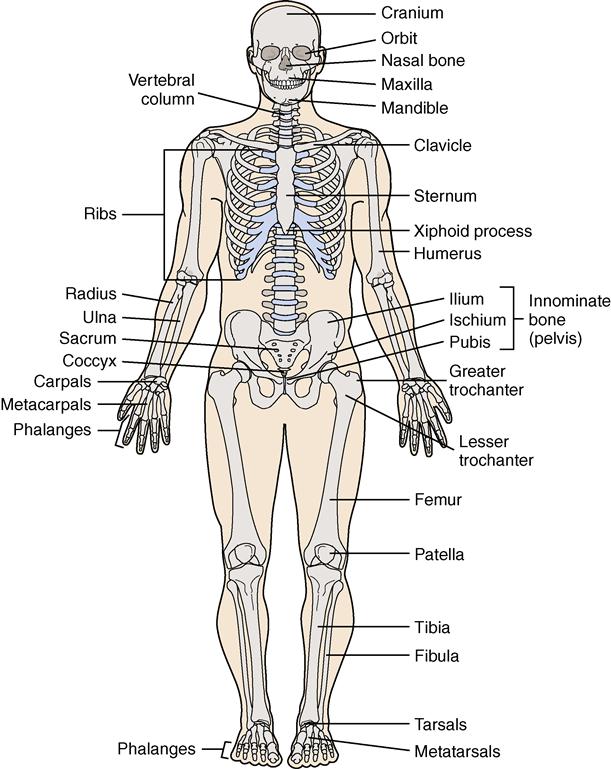
Bones are hard, rigid structures. They are made up of living cells. They are covered by a membrane called periosteum. Periosteum contains blood vessels that supply bone cells with oxygen and food. Inside the hollow centers of the bones is a substance called bone marrow. Blood cells are formed in the bone marrow.
Joints
A joint is the point at which two or more bones meet. Joints allow movement (Chapter 26). Cartilage is the connective tissue at the end of the long bones. It cushions the joint so that the bone ends do not rub together. The synovial membrane lines the joints. It secretes synovial fluid. Synovial fluid acts as a lubricant so the joint can move smoothly. Bones are held together at the joint by strong bands of connective tissue called ligaments.
There are three major types of joints (Fig. 9-6):
• Hinge joint allows movement in one direction. The elbow is a hinge joint.
• Pivot joint allows turning from side to side. A pivot joint connects the skull to the spine.
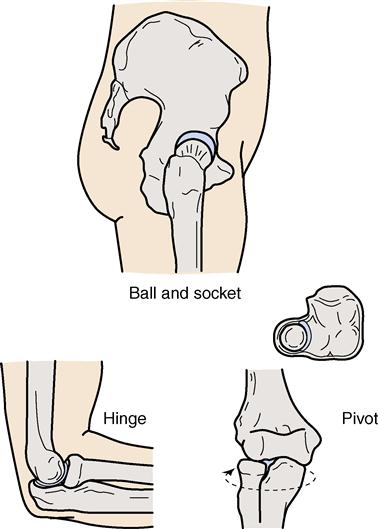
Muscles
The human body has more than 500 muscles (Figs. 9-7 and 9-8). Some are voluntary. Others are involuntary.
Strong, tough connective tissues called tendons connect muscles to bones. When muscles contract (shorten), tendons at each end of the muscle cause the bone to move. The body has many tendons. See the Achilles tendon in Figure 9-8. Some muscles constantly contract to maintain the body’s posture. When muscles contract, they burn food for energy. Heat is produced. The more muscle activity, the greater the amount of heat produced. Shivering is how the body produces heat when exposed to cold. Shivering is from rapid, general muscle contractions.
The nervous system
The nervous system controls, directs, and coordinates body functions. Its two main divisions are:
• The central nervous system (CNS). It consists of the brain and spinal cord (Fig. 9-9).
• The peripheral nervous system. It involves the nerves throughout the body (Fig. 9-10).
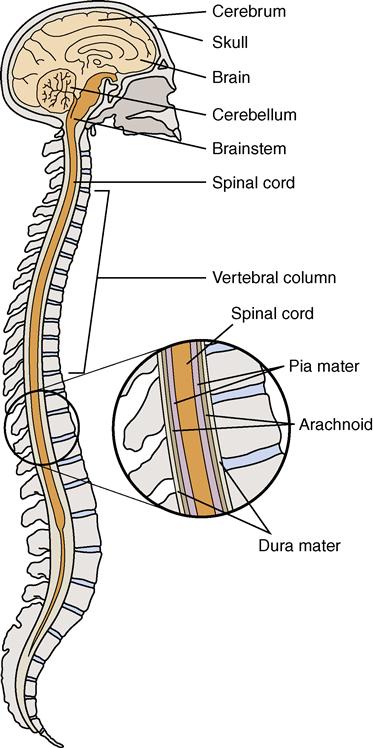
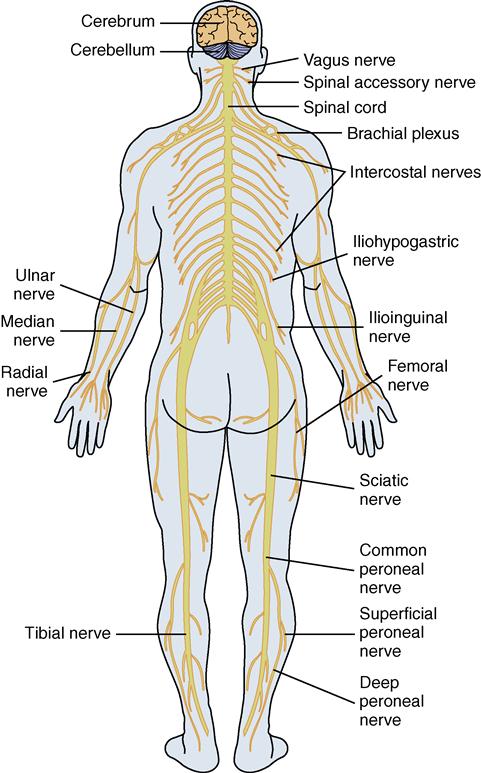
Nerves carry messages or impulses to and from the brain. Nerves connect to the spinal cord. They are easily damaged and take a long time to heal. Some nerve fibers have a protective covering called a myelin sheath. The myelin sheath also insulates the nerve fiber. Nerve fibers covered with myelin conduct impulses faster than those fibers without it.
The central nervous system
The brain and spinal cord make up the central nervous system. The brain is covered by the skull. The three main parts of the brain are the cerebrum, the cerebellum, and the brainstem (Fig. 9-11).
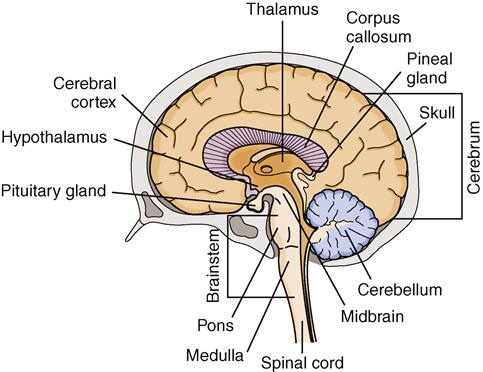
The cerebrum is the largest part of the brain. It is the center of thought and intelligence. The cerebrum is divided into two halves called the right and left hemispheres. The right hemisphere controls movement and activities on the body’s left side. The left hemisphere controls the right side.
The outside of the cerebrum is called the cerebral cortex. It controls the highest functions of the brain. These include reasoning, memory, consciousness, speech, voluntary muscle movement, vision, hearing, sensation, and other activities.
The cerebellum regulates and coordinates body movements. It controls balance and the smooth movements of voluntary muscles. Injury to the cerebellum results in jerky movements, loss of coordination, and muscle weakness.
The brainstem connects the cerebrum to the spinal cord. The brainstem contains the midbrain, pons, and medulla. The midbrain and pons relay messages between the medulla and the cerebrum. The medulla is below the pons. The medulla controls heart rate, breathing, blood vessel size, swallowing, coughing, and vomiting. The brain connects to the spinal cord at the lower end of the medulla.
The spinal cord lies within the spinal column. The cord is 17 to 18 inches long. It contains pathways that conduct messages to and from the brain.
The brain and spinal cord are covered and protected by three layers of connective tissue called meninges:
• The outer layer lies next to the skull. It is a tough covering call the dura mater.
• The middle layer is the arachnoid.
The space between the middle layer (arachnoid) and inner layer (pia mater) is the arachnoid space. The space is filled with cerebrospinal fluid. It circulates around the brain and spinal cord. Cerebrospinal fluid protects the central nervous system. It cushions shocks that could easily injure brain and spinal cord structures.
The peripheral nervous system
The peripheral nervous system has 12 pairs of cranial nerves and 31 pairs of spinal nerves. Cranial nerves conduct impulses between the brain and the head, neck, chest, and abdomen. They conduct impulses for smell, vision, hearing, pain, touch, temperature, and pressure. They also conduct impulses for voluntary and involuntary muscles. Spinal nerves carry impulses from the skin, extremities, and the internal structures not supplied by cranial nerves.
Some peripheral nerves form the autonomic nervous system. This system controls involuntary muscles and certain body functions. The functions include the heartbeat, blood pressure, intestinal contractions, and glandular secretions. These functions occur automatically.
The autonomic nervous system is divided into the sympathetic nervous system and the parasympathetic nervous system. They balance each other. The sympathetic nervous system speeds up functions. The parasympathetic nervous system slows functions. When you are angry, scared, excited, or exercising, the sympathetic nervous system is stimulated. The parasympathetic system is activated when you relax or when the sympathetic system is stimulated for too long.
The sense organs
The five senses are sight, hearing, taste, smell, and touch. Receptors for taste are in the tongue. They are called taste buds. Receptors for smell are in the nose. Touch receptors are in the dermis, especially in the toes and fingertips.
The eye
Receptors for vision are in the eyes (Fig. 9-12). The eye is easily injured. Bones of the skull, eyelids and eyelashes, and tears protect the eyes from injury. The eye has three layers:
Stay updated, free articles. Join our Telegram channel

Full access? Get Clinical Tree



